The clash between the WSL’s two title contenders was always going to be a special game, and Manchester City Women and Chelsea Women did not disappoint, with football of the highest quality on show at the Academy Stadium, and there were some interesting tactical ideas to pick out. In this tactical analysis, we will look at Chelsea’s attack and defence, providing analysis of the difference in their first and second half play, as well as Manchester City’s pressing around the pitch, and how it affected the game.
Lineups

Manchester City Women made just one change from the team that defeated Aston Villa 8-0 in the Women’s FA Cup last weekend, with Sam Mewis coming in for Laura Coombs, who took the USA international’s place on the bench. With Gemma Bonner having departed for NWSL side Racing Louisville and England captain Steph Houghton still out injured, left-back Alex Greenwood continued in central defence, partnering USA defender Abby Dahlkemper, who joined the club in January. The now familiar front three of former Everton Women forward Chloe Kelly, Ellen White and Lauren Hemp started together once again.
Chelsea Women, meanwhile, made eight changes from their FA Cup hammering of Women’s Championship side London City Lionesses, with many of their first-team players returning after being rested. Jess Carter moved from centre-back to right-back, with Maren Mjelde out for the rest of the season, whilst captain and centre-back Magdalena Eriksson, who left the pitch injured at the weekend, also missed this game. Other than Carter, only Melanie Leupolz and Erin Cuthbert kept their places, with goalkeeper Carly Telford, defenders Hannah Blundell and Jorja Fox, and midfielders Niamh Charles (formerly of Liverpool Women) and Drew Spence all moving to the bench. Wales midfielder Sophie Ingle played alongside Millie Bright in defence, filling in for Eriksson, whilst Jonna Andersson, Ji So-yun, Fran Kirby, Pernille Harder and Sam Kerr also came in.
Manchester City Women’s pressing
With Manchester City Women two points behind Chelsea Women going into this game, it was expected that they would be on the front foot and chasing the game, looking to dominate play as much as possible. Therefore, it came as no surprise to see them pressing Chelsea, trying to force them into making mistakes with the ball.
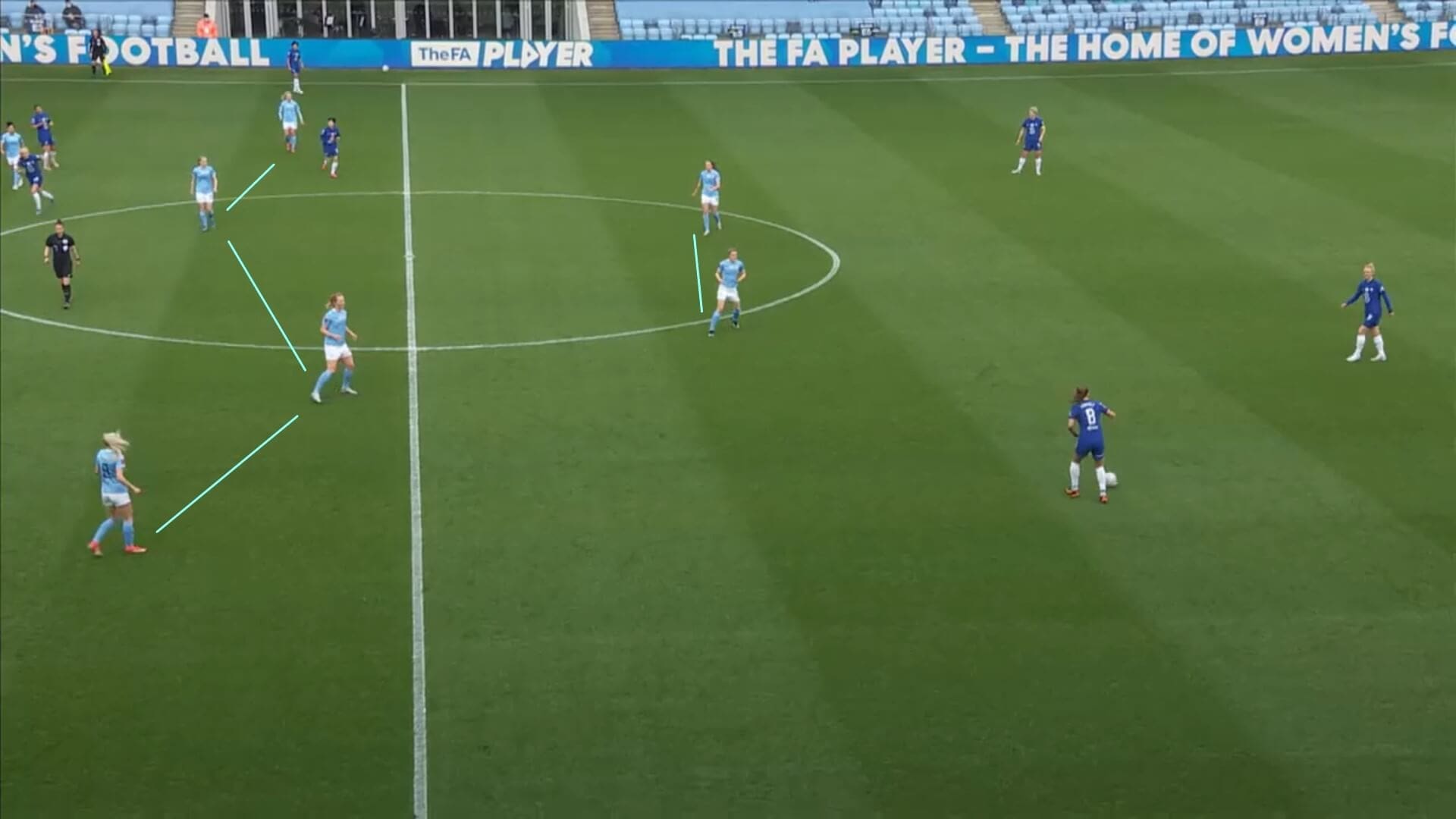
Manchester City started with a 4-3-3 formation, but were flexible in the way players moved around the pitch during the game. In this image, we see how they have moved into a 4-4-2, with Caroline Weir moving up the field to join Ellen White in the forward line. With Weir and White both having pace in attack, they could press the Chelsea defenders and force them into moving the ball quicker, increasing the chance of a mistake being made.
At the same time, the two wide attackers, Chloe Kelly and Lauren Hemp, dropped back to play either side of Sam Mewis and Kiera Walsh. Again, both are quick players, so can move forward as needed to help when pressing, focusing particularly on the Chelsea full-backs. Manchester City were undoubtedly the better team in the opening stages of the first half, and this tactical approach to their attack was one major reason for this.
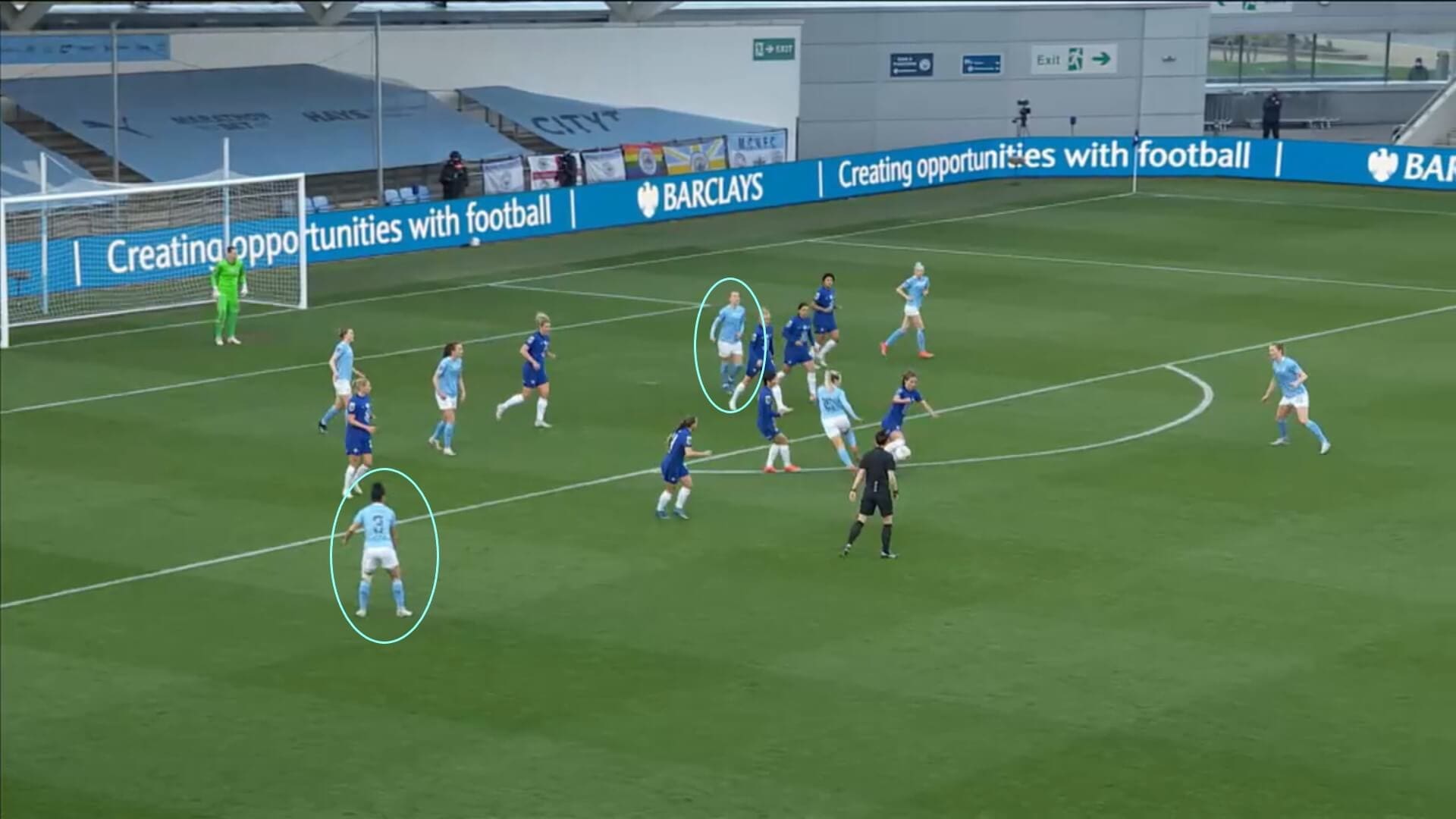
When it came to pressing Chelsea from the front, it wasn’t just the midfielders and forwards involved. Here, the two full-backs, Lucy Bronze and Demi Stokes, are both circled, and this demonstrates how far forward both got. They tended to position themselves in and around the goal area, giving Manchester City extra options in attack, and helping to increase their presence in the final third.
This image is from the second half, which shows how having attacking full-backs was something the home side had planned tactically. Bronze in particular was a big threat throughout, always getting into good positions, and set up a number of chances for her teammates.
However, this is actually a regularity for Manchester City, and is a key part of their overall play. By doing so here, though, they looked to prevent Chelsea’s full-backs advancing up the pitch, which would have given Chelsea the edge. As a result, Jess Carter and Jonna Andersson were kept relatively quiet in the first half, which was testament to the way Manchester City forced them to stay back by pushing Bronze and Stokes high up the pitch.
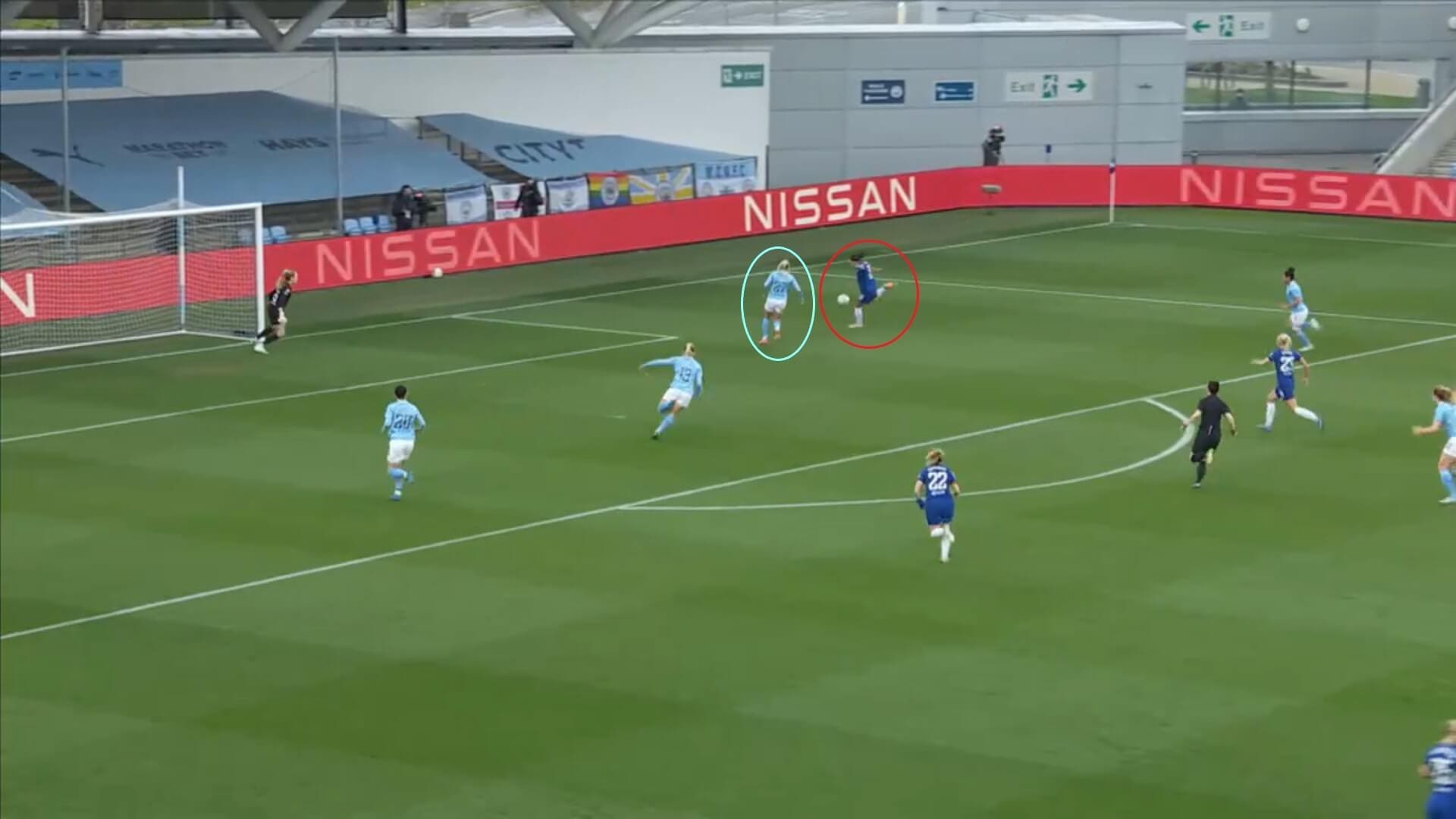
It wasn’t just in the final third that Manchester City pressed Chelsea’s players. Here, we see how Chelsea’s Australia striker Sam Kerr has broken through the defence, looking to shoot at goal. However, Alex Greenwood, in the blue circle, has got back to block her shot, with this being only one example of the many 1-v-1 battles these two had throughout the game.
What is particularly notable here is that Greenwood moves towards Kerr, rather than simply cutting across her line of sight. This takes more time away from the Chelsea striker, making it less likely her shot will trouble Manchester City’s goal. Being a natural left-back, former Lyon Feminin player Greenwood has plenty of pace, and is used to getting out to opponents to close them down; this quality helped her to reach Kerr quickly in these situations.
Manchester City undoubtedly started better than Chelsea in this game, helped by their careful tactical planning. Their ability to keep Chelsea quiet in the opening stages shows how far they have come this season under Gareth Taylor, and how all of their signings have added something to the team, giving them increased quality across the pitch.
Chelsea Women’s attack
Chelsea Women’s attack tends to focus on playing through the thirds, using the midfielders to move the ball around the pitch. This season, manager Emma Hayes has played Fran Kirby and Sam Kerr around each other in the final third, creating plenty of problems for opposing defenders.
However, in the first half of this game, they had a few noticeable problems.
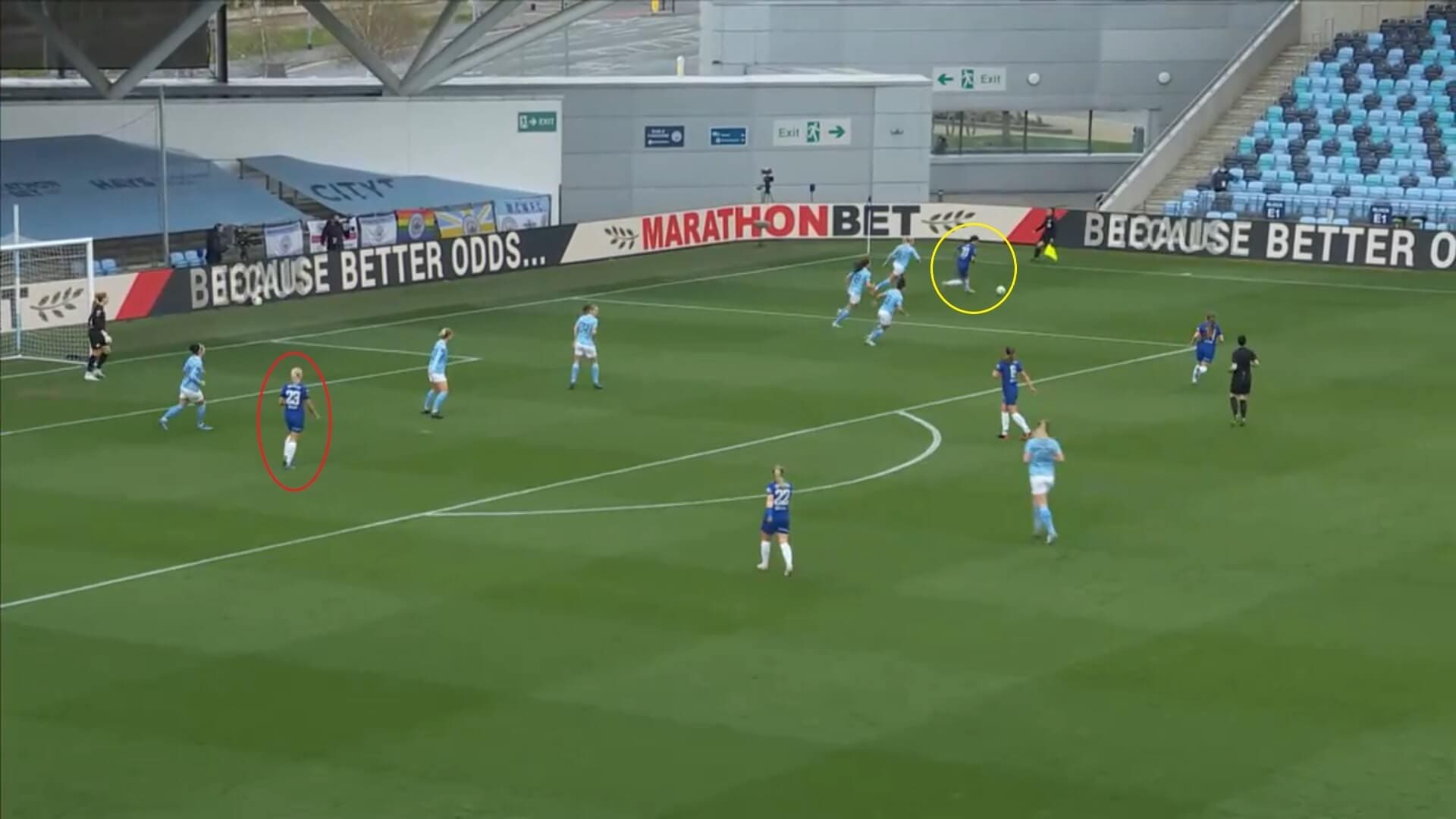
For this game, Chelsea deployed Fran Kirby on the right side of the attacking midfield, with Denmark star Pernille Harder in the role of the 10. This meant that, as can be seen in this image, when Kerr was dragged out wide, Harder was the one moving into the box to occupy the space and offer the passing option. However, for one reason or another, the dynamic wasn’t working, and Chelsea struggled to create many good attacking chances. This is another reason that Manchester City Women dominated the early stages of the game; they were more oiled in attack, with players getting into good positions and everything clicking, unlike with Chelsea.
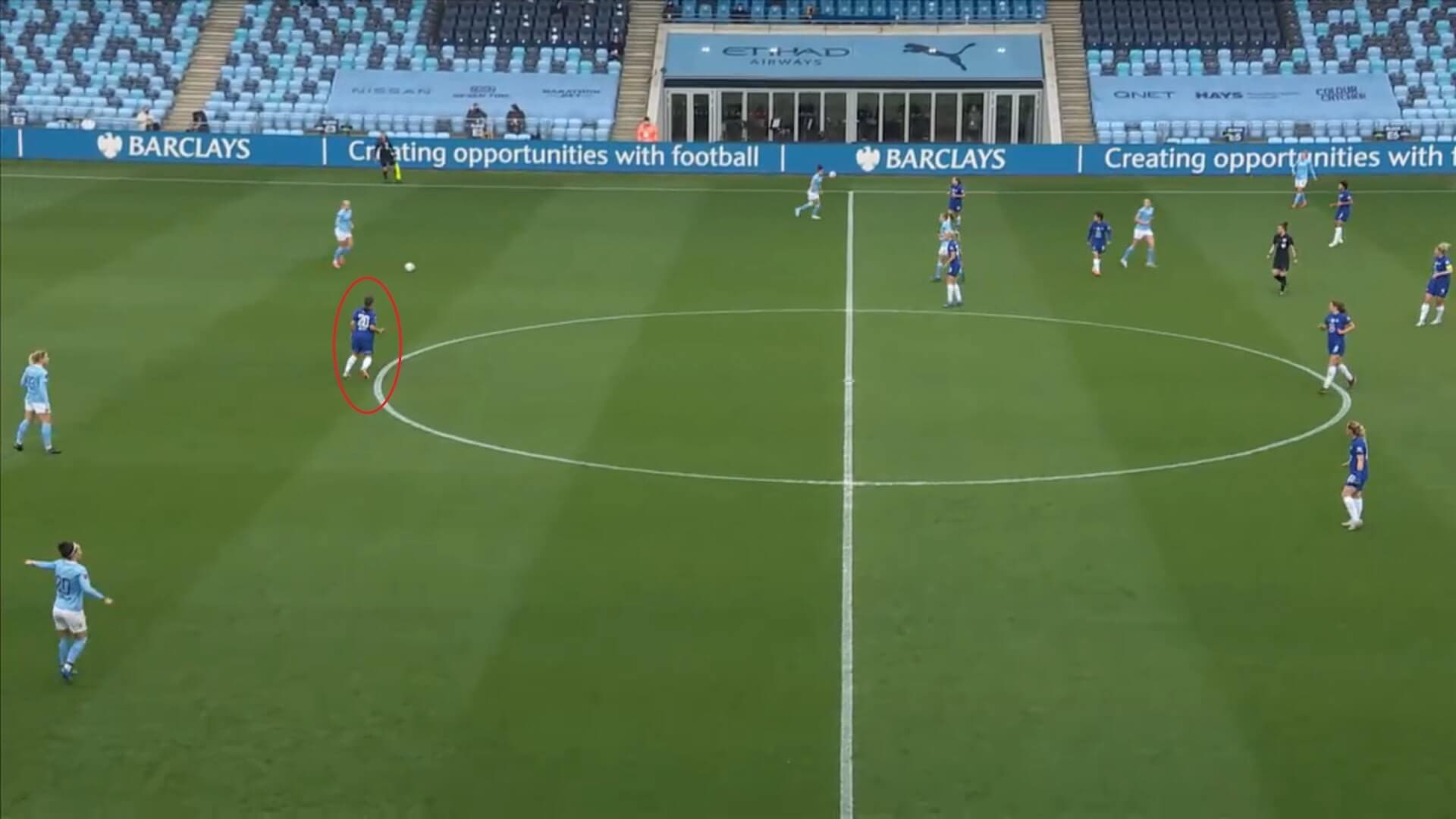
Chelsea were also sitting back at times, with sometimes only Kerr being in the attacking half. This was perhaps because of the threat Manchester City have in attack, with the likes of Sam Mewis, Kelly, Hemp and White all on the pitch, but it also meant that Chelsea were giving the opposing defenders time to stretch across the pitch and pass the ball around, not under any pressure from the away side. Therefore, again, Chelsea’s attacking tactics weren’t working, and they lacked quality in the early parts of the game.
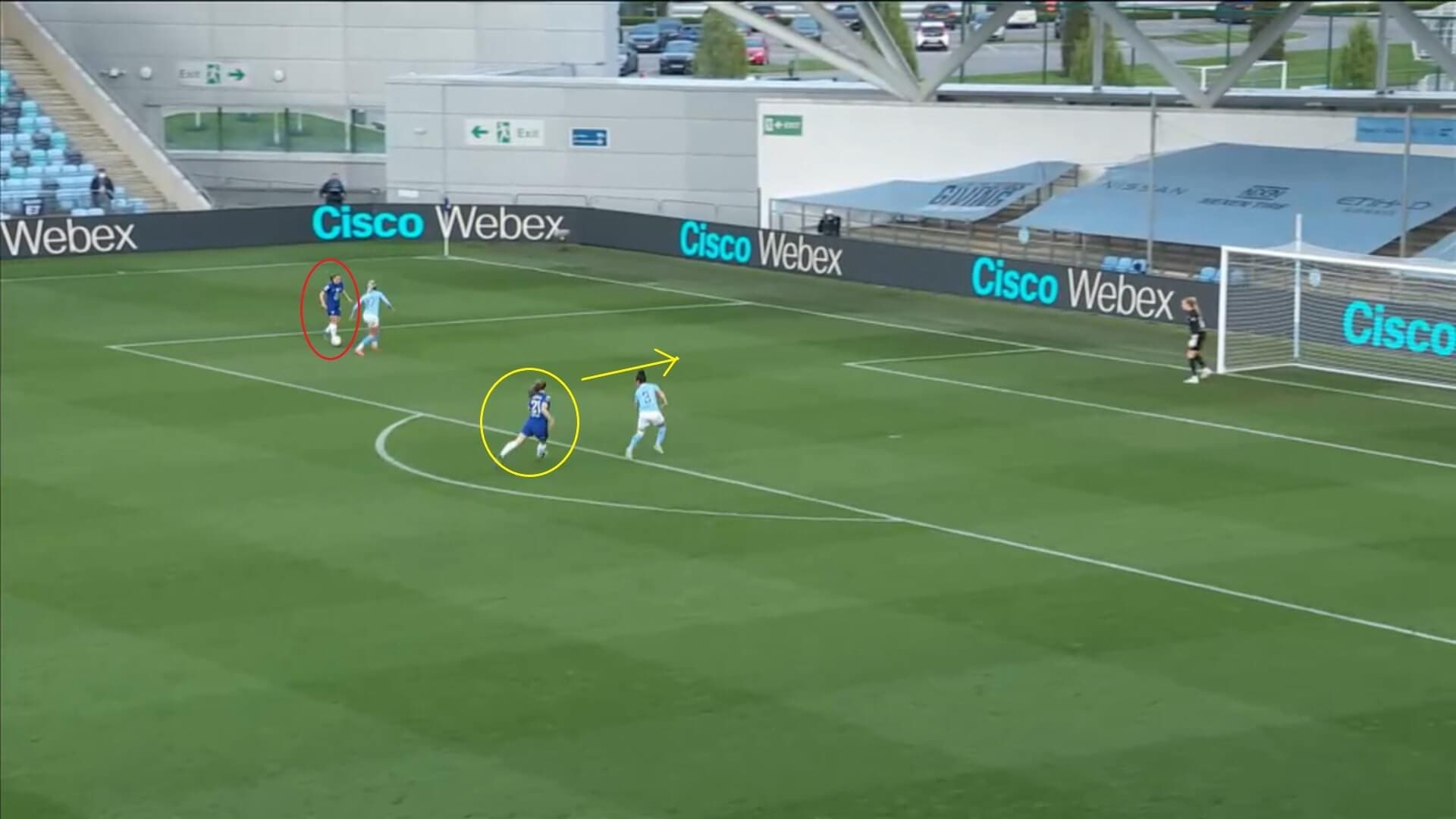
Early in the second half, Chelsea boss Emma Hayes made a change, taking Harder off and putting on Niamh Charles. Charles is a wide attacker, normally operating as a forward, but has natural pace and a direct running ability that means she can play as an attacking midfielder too. This gave Chelsea more flexibility in attack, allowing them to pose more of a threat to Manchester City’s defence.
The player who benefitted the most from Charles’ arrival was Kirby, as she had not been able to get into the box and affect play too often beforehand. However, in this image, we can see how she is taking on an opponent, with her new positional freedom meaning she posed more of a threat in the second half. Charles, who had a similarly free role, is making a run into the box to offer her a passing option.
Therefore, the underlying point here is that Chelsea perhaps didn’t get their starting XI right, with key players not able to influence the game in their usual fashion. Certainly, and perhaps surprisingly, they looked better without Harder, the 2020 UEFA Women’s Player of the Year, on the pitch.
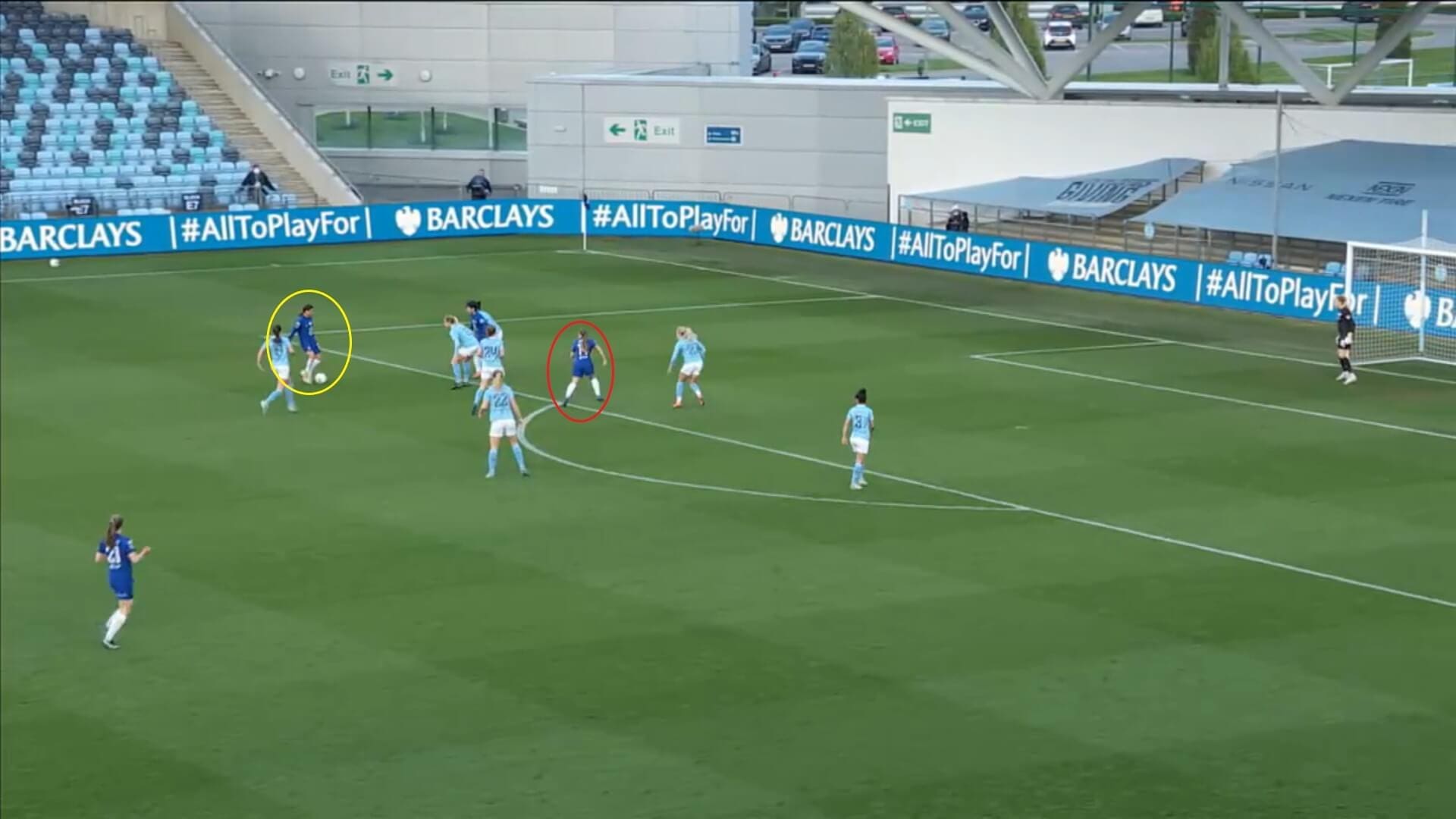
This image shows another way that Kirby’s individual performance improved in the second half, causing more problems for Manchester City. Here, Kerr has the ball, with Kirby, in the red circle, making a move behind the defenders and into the space. With Kirby and Kerr operating in closer proximity to each other in the second half, Chelsea looked much more like themselves, and Manchester City found it more difficult to deal with them for most of the second half as a result.
If we compare this to the first half, when Harder was the only one making runs into the box, we see how freeing up Kirby was a turning point in the game for Chelsea, helping them to take a draw when, at one point, it looked like they could struggle to match Manchester City’s threat.
Chelsea Women’s defence
Chelsea Women’s defence also had some interesting tactical ideas, and it was clear that they knew this part of the team had to be strong, working hard to keep Manchester City Women’s key attackers out.
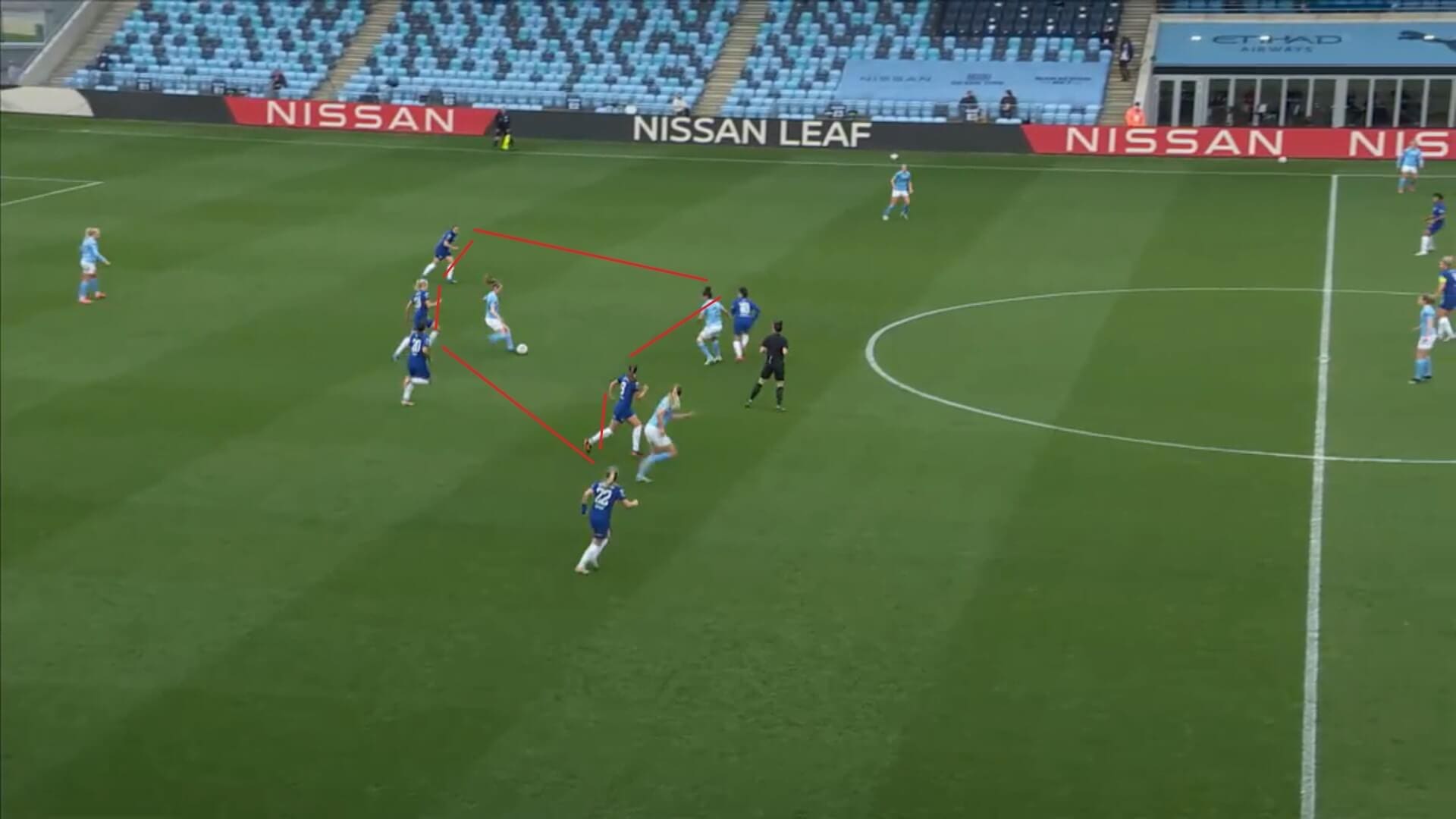
We mentioned in the last section how Chelsea only had one player in Manchester City’s half early on, but that changed after they had scored the opening goal. Now, more Chelsea players have poured forward, putting more pressure on Manchester City to move the ball around quicker. With their superior numbers, Chelsea surrounded whichever player had the ball (in this case, Kiera Walsh), before all moving inwards together to close down the space.
On this occasion, Walsh’s pass actually led to the equalising goal from Kelly, but there were plenty of times when Manchester City played loose passes under pressure, allowing Chelsea to win the ball and attack forwards. Therefore, it did seem that Chelsea’s first goal provided them with the spark they needed, and they posed a greater threat to Manchester City afterwards.
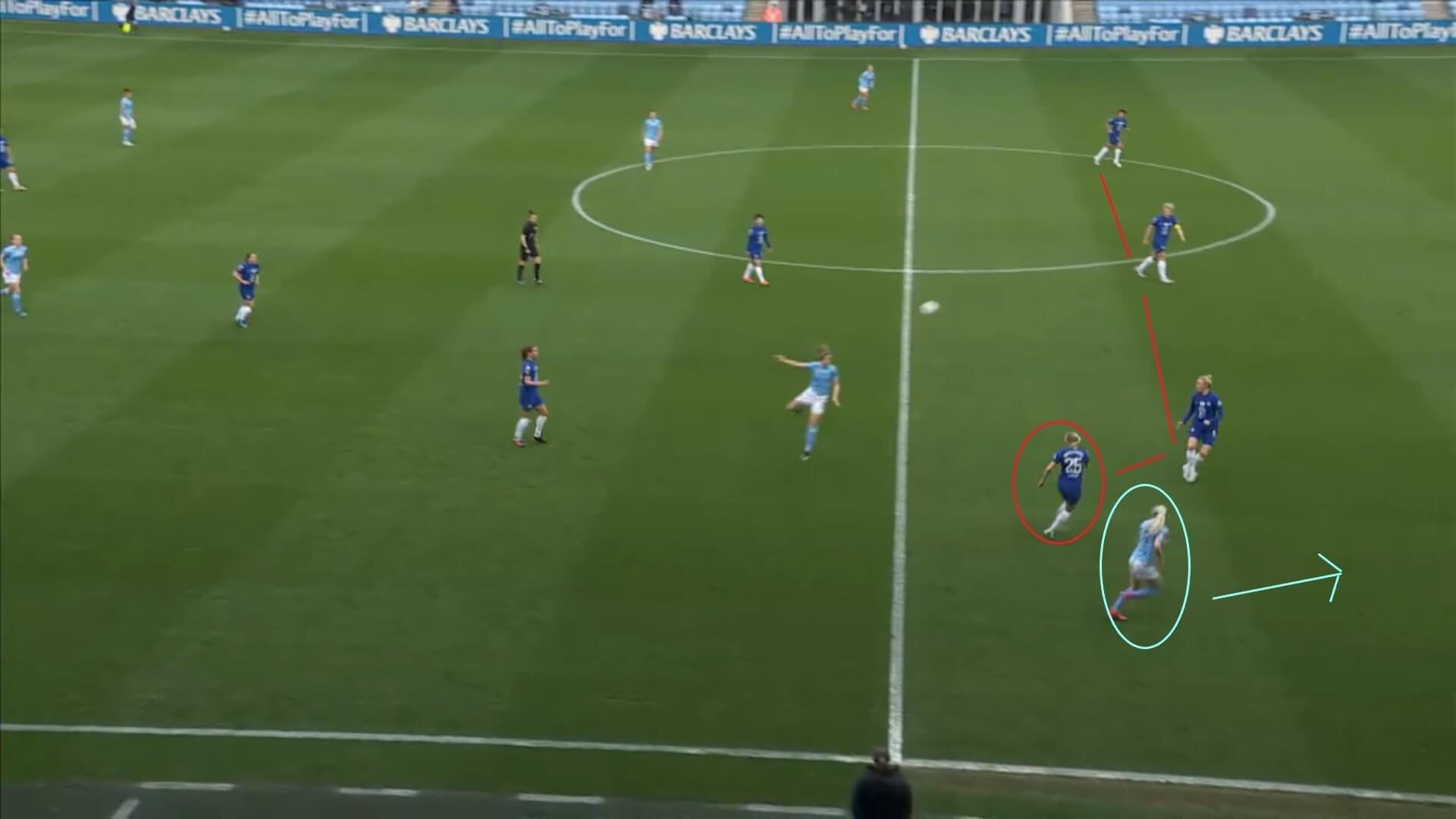
One thing we noticed a lot was that Chelsea’s defensive line was playing high up the pitch. This is not unusual for them, with the likes of Millie Bright often involved in moving balls into attack from these areas. However, it only works if all the defenders are in a line, because that forces opposing attackers to play the ball around or over the top of the line, which is harder and riskier for them.
The thing is that Chelsea like to push their full-backs high up the pitch, as already mentioned, but left-back Andersson hasn’t slotted back in here after making a forward run. The problem now is that the space has opened up for Chloe Kelly, in the blue circle, to run behind them, accessing the space behind, and this is where she is dangerous. Ellen White, who typically plays on the shoulder of the opposing defenders, was also making these runs behind, so it was a regular occurrence in the first half. Whilst they never tended to lead to anything, Manchester City constantly found these spaces behind Chelsea’s defence, which was another key reason for their dominance in the opening stages of the game.
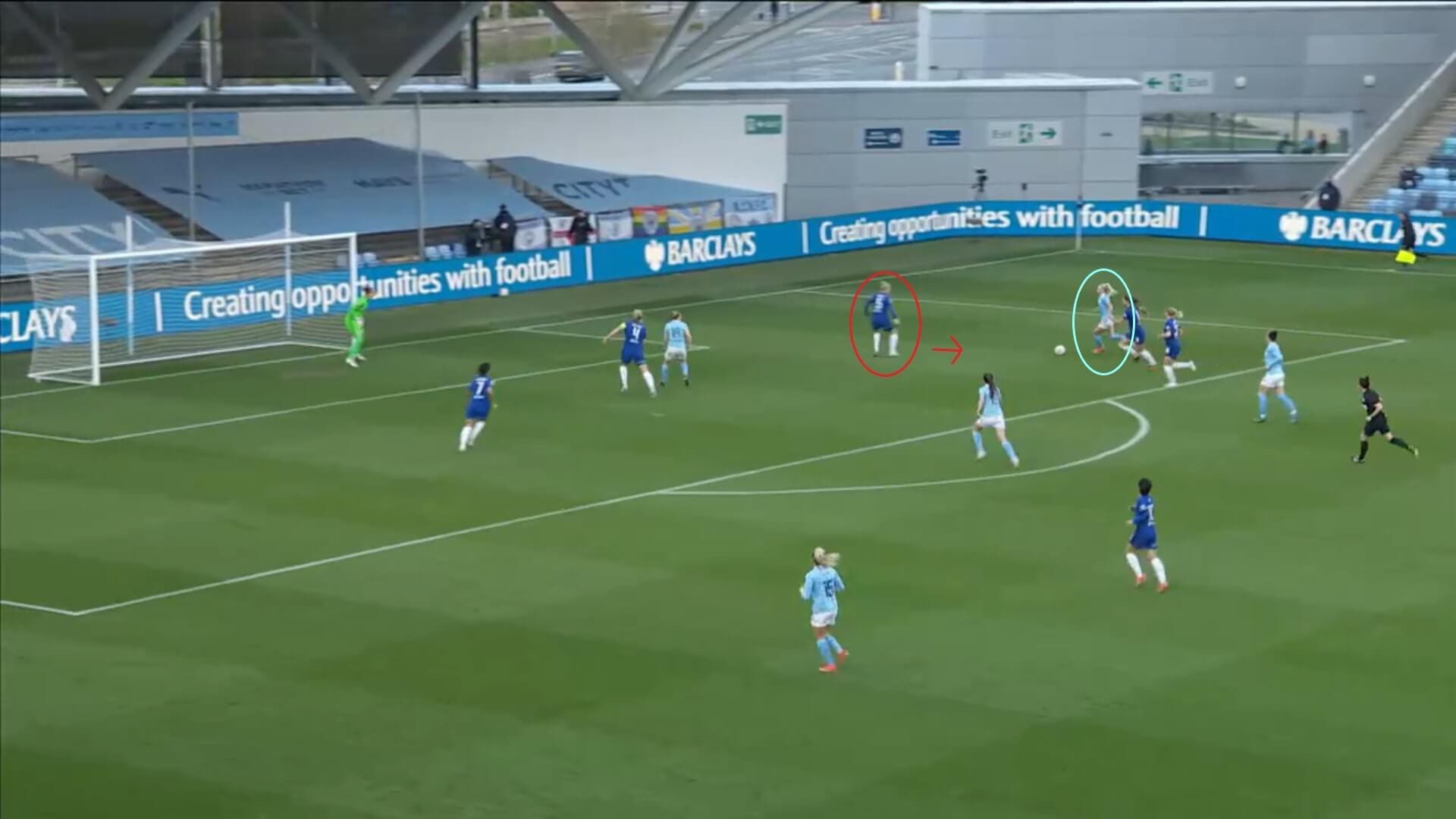
Like with their attack, Chelsea seemed to gain more confidence in defence after scoring their opening goal. Here, we see how, in the second half, Sophie Ingle is closing down Chloe Kelly, and there are a few tactical points we can pick out here.
Firstly, Ingle is a defensive midfielder by trade, and one of her key traits is seeing passes before they are made, positioning herself early to make interceptions. Here, she has seen where Kelly is going, and moves towards the England forward, rather than holding her position. This takes more time away from Kelly, forcing her to make a decision quicker, whether that is passing or shooting, which increases the chance of her making a mistake.
Secondly, Ingle’s positioning allows her teammates to get back and mark Kelly’s passing options, as you can see Millie Bright and Jess Carter doing here. Therefore, we see how Chelsea’s strength at the back helped them to keep Manchester City out, which was especially important in the second half, when both sides’ errors were being pounced on by the other team.
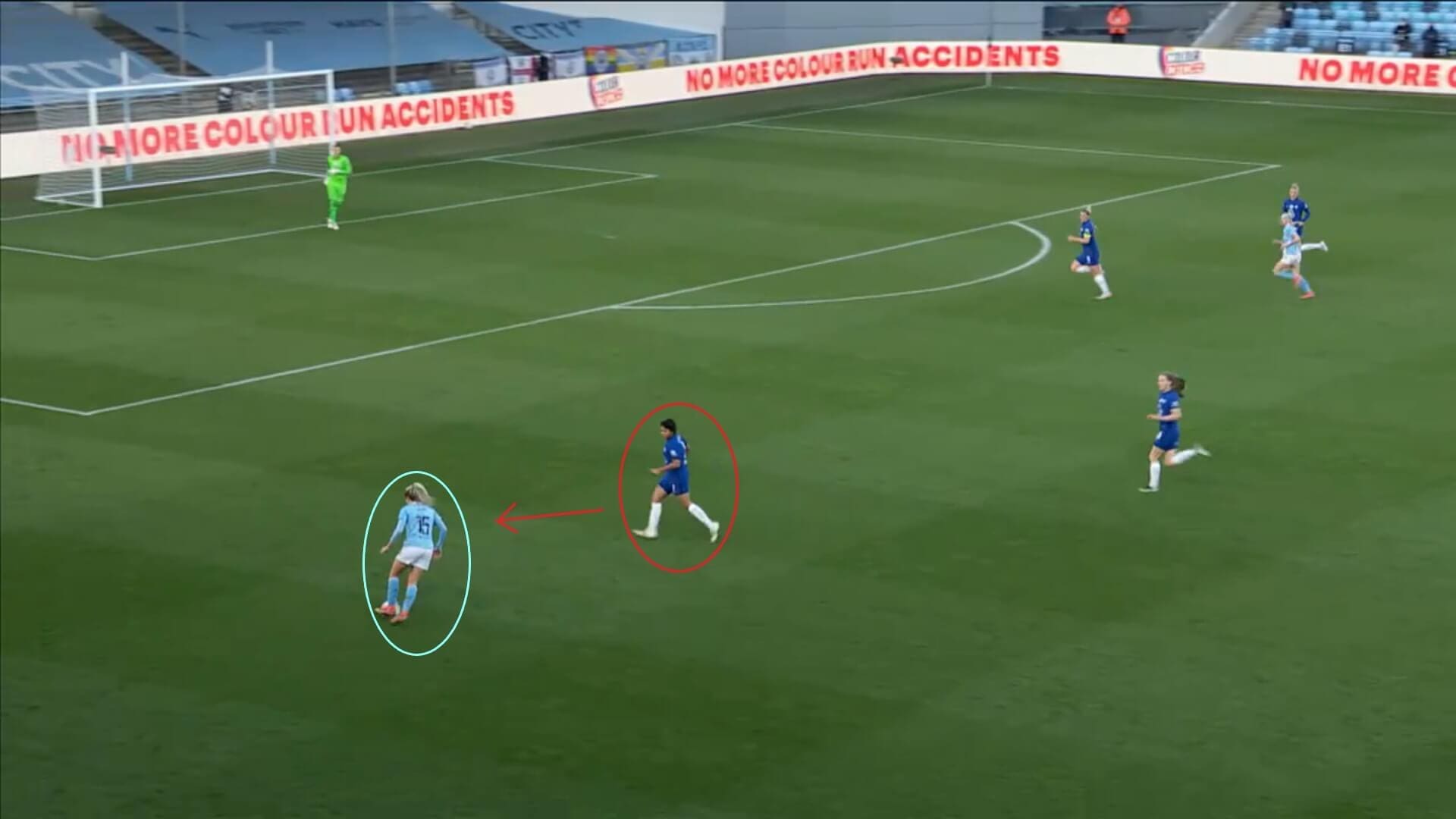
The other thing we normally associate with Manchester City is a wide forward line. Chloe Kelly was arguably their best player for most of the game, always finding spaces behind the Chelsea defence, but Lauren Hemp was involved in a lot more of their second half play. Her key ability is playing the ball into the box from very wide positions, always looking to stretch opposing defences out where possible.
Seeing her in these positions was a common occurrence after half-time, but we can also see that Jess Carter is getting across to close her down, showing how Chelsea were on the front foot more at this point, anticipating the play and making it harder for Manchester City to get back into the game.
Ultimately, it was a Chelsea mistake in defence that led to Hemp scoring the equaliser, which highlights not only how hard it was to break Chelsea down at the back, but also the defiance that Manchester City were playing with, always looking for gaps and never giving up.
Conclusion
In conclusion, this tactical analysis has shown how Manchester City Women and Chelsea Women played out an entertaining, although nerve-wracking draw, leaving both teams one point better off than beforehand. This was perhaps expected, with both having quality in defence and attack, meaning that, in part, they cancelled each other out.
Chelsea will perhaps be happier with the point, as it leaves them in control of their own fate with regards to the title race, but Manchester City boss Gareth Taylor will see the positives of the result; they took Chelsea to the edge, and ultimately were unlucky to not come away with all three points, given the way they played and the chances they created. Not many have forced Chelsea to think as much as they did in this game, and that again demonstrates how far the home side have come this season, and how, if they keep on improving, next season could be their big chance to take the WSL title from Chelsea.
Manchester City’s next game sees them host struggling Birmingham City Women on 2 May, whilst Chelsea are next in action this weekend, travelling to Bayern Munich for the first leg of their last four tie in the Women’s Champions League on Sunday afternoon.





Comments